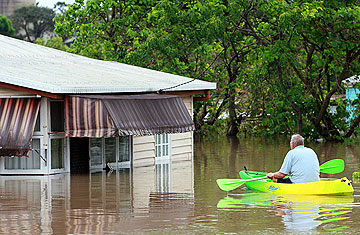
A resident evacuates his flooded home by kayak in Bundaberg, Australia, on Dec. 29
In June, Queensland was mired in a trying, decade-long drought. The eastern Australian state's Primary Industries and Fisheries website offered advice to farmers on how to feed their livestock when water was tight, and provided links to counseling and support for those that couldn't handle the stress of another failed crop. But by spring, the rainfall was well above average. The sand-colored fields turned green, and farmers began to look forward to a decent crop.
But it seems that in Australia, when it rains it pours. On Christmas day, the coast of Queensland, dubbed, ironically, Australia's "Sunshine State," was hit by Cyclone Tasha, a category one cyclone. In the days since, the newly verdant countryside, foodbowls and all, has turned to mud. "It's worse than the drought," says Mark Jensen of Jensen's Market Supplies in Brisbane, the state capital. "Some farmers have simply lost their yearly income."
By New Years Eve, half of Queensland was declared a disaster zone. More than 200,000 people were affected by three major river systems that are currently overflowing. Twenty-two towns are now isolated due to flooded roads that cover an area larger than the size of France and Germany combined. "This is without a doubt a tragedy on an unprecedented scale," Queensland's Premier Anna Bligh, told the Australian Broadcasting Corporation (ABC) yesterday. "Federal and state governments will be investing billions in the rebuilding effort."
Prime Minister Julia Gillard, who is now touring the flooded areas, has pledged $1018 per adult, and $407 per child to those whose homes have been damaged. "My concern is for the people in these very difficult times," she told reporters in Queensland. A national relief fund is currently raising money for the victims, and food is being flown into areas cut off by the worst floods in 50 years.
The Farmers' Lobby group AgForce estimates half Queensland's agricultural crop has been damaged. The rockmellon harvest from Chinchilla was wiped out, as were watermelons pumpkins and tomatoes from surrounding towns. Several coal companies in the region, including Peabody Energy, Rio Tinto Ltd and BHP Billiton, have announced a force majeure — a clause that frees a company from liability if they are unable to miss deliveries because of circumstances beyond their control. The Queensland Resources Council, a not-for-profit industry body, says the losses in coal and gas production would run into hundreds of millions of dollars, and that a rise on the current $225 price per ton of coking coal, a key Australian export, is inevitable.
The cost of vegetables has already risen, with prices on produce like sweet potato and seedless watermelons quadrupling in the space of a week. Melon, mango, bell peppers, tomato, lettuce, grapes and bananas are all set to become more expensive, as some fruit and vegetables may have to be imported due to the current lack of supply. "Prices will go up at least 50%," says Jensen in Brisbane. "But what consumers have to remember is that for them it's just a few extra dollars at the supermarket. That's nothing compared to the hundreds of farmers who have lost close to everything."
